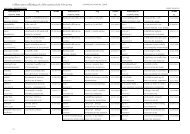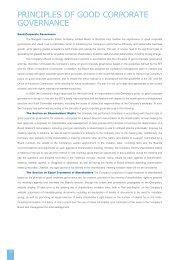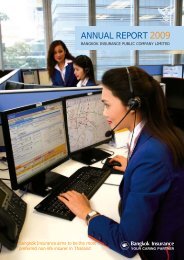Year 2007
Year 2007
Year 2007
You also want an ePaper? Increase the reach of your titles
YUMPU automatically turns print PDFs into web optimized ePapers that Google loves.
Foreign Currency Risk<br />
The Company’s exposure to foreign currency risk arises mainly from foreign currency denominated underwriting, reinsurance<br />
with foreign reinsurers and investments in foreign associated companies that are denominated in foreign currencies. The Company<br />
does not utilise forward foreign currency contracts to mitigate its exposure to foreign currency risk.<br />
As at December 31, <strong>2007</strong>, the balances of financial assets and liabilities denominated in foreign currencies are<br />
summarised below.<br />
Foreign Currency Financial Financial Average Exchange Rate<br />
Assets Liabilities as at December 31, <strong>2007</strong><br />
(Million) (Million) (Baht per 1 foreign currency unit)<br />
US Dollar 3.6 3.1 33.718<br />
Philippines Pesos 0.6 - 0.813<br />
Japanese Yen 3.6 18.0 0.296<br />
HK Dollar 1.3 - 4.321<br />
Indonesia Rupiahs 1,634.1 - 0.003<br />
23.2 Fair value<br />
A fair value is the amount for which an asset can be exchanged or a liability settled between knowledgeable, willing<br />
parties in an arm’s length transaction. The fair value is determined by depending on the nature of the instrument.<br />
The fair value is determined by reference to the market price of the financial instrument or by using an appropriate<br />
valuation technique if the appropriate market price cannot be determined, depending on the nature of the instrument.<br />
The following methods and assumptions were used by the Company in estimating the fair values of financial instruments:<br />
- Investment in securities<br />
The fair value of equity securities and debt securities are based on their quoted market prices.<br />
The fair value of other securities cannot be properly calculated, and therefore no disclosure is made.<br />
The investments in associated companies are accounted for under the equity method (investments in associated<br />
companies are valued at cost in separate financial statements).<br />
The fair value of deposits at financial institutions, and notes with maturity periods of less than 90 days is based<br />
on their carrying value. For those with maturity periods longer than 90 days, fair value is estimated using a<br />
discounted cash flow analysis based on the current interest rate and the remaining period to maturity.<br />
- Secured loans<br />
For floating interest rate loans with no significant credit risk, fair value is based on carrying value. The fair value<br />
of fixed interest rate loans is estimated using a discounted cash flow analysis based on the current interest rate.<br />
24. Approval of Financial Statements<br />
These financial statements were authorised for issue by the Company’s Executive Directors on February 15, 2008.<br />
80







